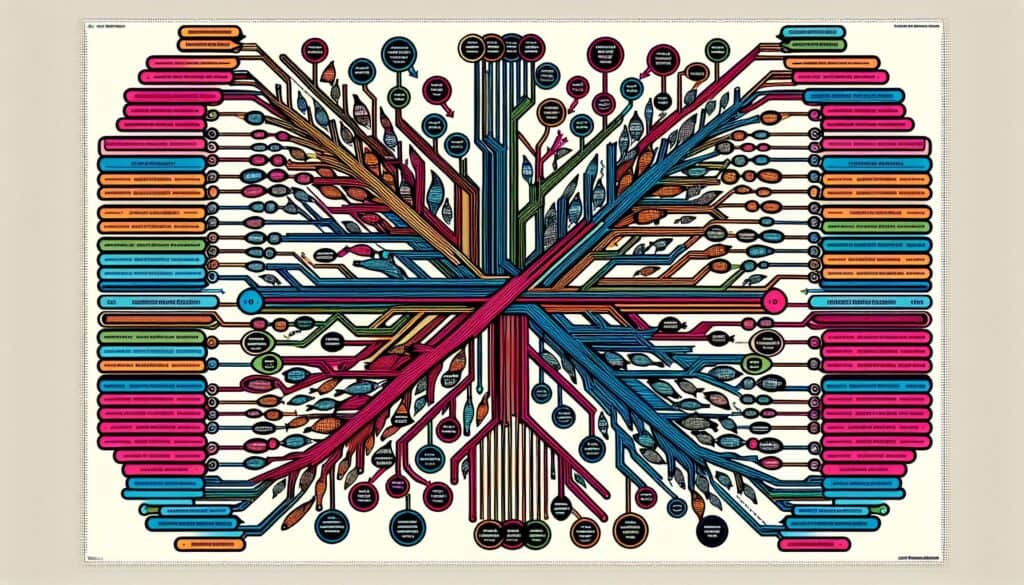To visually brainstorm and categorize the potential causes of a specific problem (the “effect”) to identify its root causes.
- 方法: 工程, 质量
Fishbone Diagram (Ishikawa Diagram)

Fishbone Diagram (Ishikawa Diagram)
- 集思广益, 持续改进, 解决问题的技巧, 过程, 质量管理, 根本原因分析, 团队合作, 价值流映射
目标
如何使用
- The problem (effect) is written at the "head" of the fish. Main categories of causes (e.g., People, Process, Equipment, Materials, Environment, Management - or others relevant to the context) form the "bones." Teams brainstorm specific causes within each category.
优点
- Provides a structured way to brainstorm a wide range of potential causes; Visually organizes complex causal relationships; Encourages team participation and diverse perspectives; Helps to look beyond obvious symptoms.
缺点
- Can become very complex and cluttered for multifaceted problems; Does not inherently quantify the impact of different causes; The identified causes are potential and require further investigation and validation.
类别
- 构思, 精益西格玛, 制造业, 解决问题, 质量
最适合:
- Brainstorming and exploring all potential causes of a specific problem in a structured, visual way.
The Fishbone Diagram, or Ishikawa Diagram, is particularly useful in industries such as manufacturing, healthcare, and software development for identifying root causes of quality issues. Commonly employed during the analysis phase of problem-solving, teams typically initiate this methodology during brainstorming sessions that draw participants from diverse functions including engineering, quality assurance, operations, and management. By categorizing causes into defined groups such as People, Process, Equipment, Materials, Environment, and Management, teams can explore not just immediate factors but also underlying systemic issues contributing to a problem. This structured approach encourages collaborative input from all members, fostering a culture of engagement and shared responsibility in troubleshooting. For instance, in a product development setting, a Fishbone Diagram might be used to dissect delays in a project timeline, allowing teams to systematically address challenges ranging from resource allocation to communication breakdowns. The diagram’s visual representation enables stakeholders to grasp the interconnections among various causes, making it a practical tool for continuous improvement initiatives or root cause analysis in six sigma projects, enhancing the quality of products and services delivered. This method can be beneficial in various scenarios, such as during the review of customer feedback regarding product defects or when addressing inefficiencies in operational workflows, ensuring a comprehensive exploration of potential sources of problems while steering clear of symptomatic fixes.
该方法的关键步骤
- Identify and clearly define the problem or effect at the head of the diagram.
- Select main categories of causes relevant to the specific issue.
- Draw lines representing each category as main branches from the spine of the fish.
- Conduct a brainstorming session for each category to identify specific causes.
- Add sub-branches for each specific cause that emerge from the main branches.
- Encourage discussion and refine causes for clarity and relevance.
- Review the diagram for completeness and ensure all potential causes are represented.
专业提示
- Utilize a pre-brainstorming survey to gather initial thoughts, ensuring all team members contribute before the meeting.
- Incorporate different fishbone diagrams for various categories to prevent overlapping thoughts and enhance clarity.
- Facilitate a second round of discussion where teams prioritize causes based on impact and likelihood, refining the direction for further analysis.
历史背景
1962
1970
1972
1980
1980
1986
1986
1960
1963
1970
1980
1980
1980
1986
1987
(如果日期不详或不相关,例如 "流体力学",则对其显著出现的时间作了四舍五入的估计)。















相关文章
METS 卡路里计算器
元分析
信息映射
心理模型图
可接受的最大推力和拉力
物料需求计划(MRP)